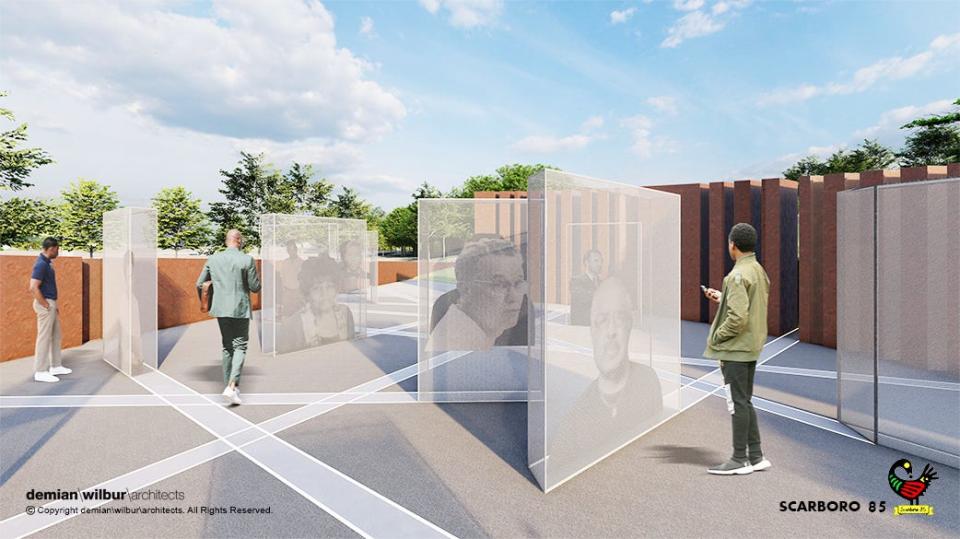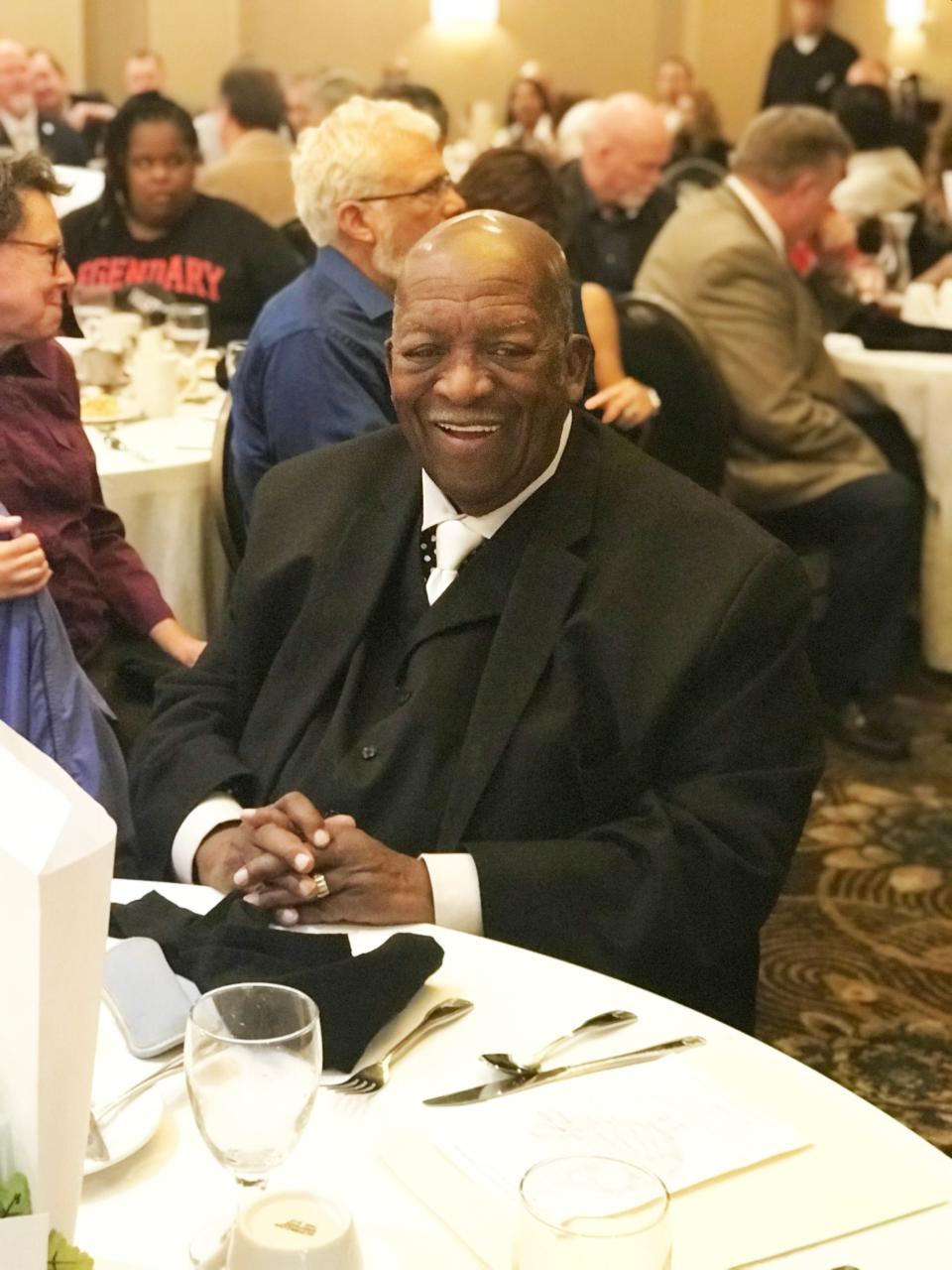Scarboro 85 Monument in Oak Ridge to honor students for their place in history
John Spratling, chair of the Scarboro 85 Monument committee, said he and others will not rest until the 85 students from Oak Ridge's Scarboro Community, now in their 80s, get their rightful place in Civil Rights movement history.
They were the first large group of Black students to integrate schools in the Southeast.
To help with that recognition for their roles in history, the committee is planning for a $2 million-plus monument in A.K. Bissell Park at the former site of the Oak Ridge International Friendship Bell.
The new Scarboro 85 Monument will be a "sign that Oak Ridge stood while others would not," said the Rev. Harold Middlebrook, a civil rights leader and friend of the late Martin Luther King Jr.
Middlebrook was the keynote speaker at a sold-out fundraising and informational luncheon on the monument efforts at the Doubletree Hotel in Oak Ridge in late February.
"I come not only to celebrate the Scarboro 85, but to celebrate Oak Ridge," the 80-year-old Middlebrook said.

Oak Ridge Schools were desegregated on Sept. 6, 1955, at the order of the Atomic Energy Commission - making them the first government-run schools in the Southeast to be integrated. Martin McBride and other Scarboro 85 Monument Committee members pointed out that this integration was before:
The Clinton 12 integrated Clinton High School on Aug. 27, 1956. The Green McAdoo Cultural Center in Clinton celebrates those 12 students. The Clinton High desegregation efforts were met with protests and violence and on Oct. 5, 1958, the school was bombed.
The Little Rock Nine integrated Little Rock Central High in Arkansas on Sept. 4, 1957. The Little Rock Nine were a group of nine African American students enrolled in Little Rock Central High School in 1957. The students were prevented from enrolling in the school by the Arkansas governor. They attended only after the intervention of President Dwight D. Eisenhower.
Plans for the monument are in the preliminary phase, according to Washington, D.C.-based architect Ziad Demian, who created the Peace Pavilion that now houses the Oak Ridge International Friendship Bell in Bissell Park. He called the renderings he showed in a presentation a "framework and concept." The images showed 85 pillars representing the 85 students, white lines showing the paths or steps of the 85, and images or holograms on the interior showing people involved in the desegregation, some of the 85, as well as white adults involved.
When the Scarboro 85 started at Oak Ridge High and Robertsville Junior High schools, it was only days after that 14-year-old Emmett Till was abducted, tortured, and lynched in Mississippi after being accused of offending a white woman. McBride told the audience to imagine how frightening it was for the young 85 students, not knowing how their arrival at the all-white schools in Oak Ridge would be received.

But they had advocates at the school, notably ORHS Principal Tom Dunigan. His daughter, Pat Postma, told the luncheon audience that he had told their family, "We're not doing this because we're forced to do this, we're doing it because it's the right thing to do."
But not all in Oak Ridge supported the desegregation, McBride said. In 1953, the town council and notably chairman Waldo Cohn had asked the Atomic Energy Commission to allow them to desegregate the schools. He said there was a public outcry and a recall petition. There were enough signatures by residents for a recall vote, but the vote failed and Cohn got to remain on council. However, he did resign his chairmanship.
In 1954, the Supreme Court ruled in Brown v. Board of Education that separate school systems for Black and white students violated the equal protection clause of the Fourteenth Amendment to the U.S. Constitution. Then the next year, in 1955, the Atomic Energy Commission told Oak Ridge to integrate schools.
"I remember May 17, 1954, when that decision came down," Middlebrook said. Likewise, he remembered reading in the newspaper of the killing of Emmett Till, who was close to his age.

"I heard my Mom say, 'Be careful son, what happened to Till could easily happen to you.'"
Middlebrook said he also remembered the desegregation of schools in Oak Ridge, Clinton and Little Rock. The Knoxville resident said he wondered why the desegregation was done quietly in Oak Ridge, "but not peacefully in Clinton," although they were both in Anderson County.
Larry Gipson, born in 1940, was a 14-year-old freshman when he began attending Oak Ridge High School in 1955. At the luncheon, Gipson said he'd come from a small Southern town and he'd been told by his parents what to do when he encountered a white person on the city street: Step off the sidewalk to allow the white person to pass and don't look them in the eye.
Gipson explained that he and the still-living students who desegregated the two schools want to be referred to as the Scarboro 85 instead of Oak Ridge 85 because they want their community, where some still live and where they were all taught at the all-Black Scarboro School prior to desegregation, to be remembered.
Civil rights icon talks about the past ... and a brighter future
Middlebrook said he was there to congratulate and say thank you to the Scarboro 85.
"Our battle is not over," he said, speaking as eloquently and forcefully as if he was in the pulpit.
"This is a pause" in time to reaffirm and "to be challenged anew," he said.
"I remember what it was like to be a Negro," Middlebrook said.
"I know the humiliation of being told you're not good enough, you're nothing."
He appreciated the teachers, he said, who despite the circumstances taught him and his friends that "you can learn, you can be somebody." Those teachers were Black, he said, explaining he didn't have a white teacher until he attended Morehouse College.
He recalled telling activist Jesse Jackson that he was too late in trying to get him to be "excited" while chanting, "I am somebody."
He said Big Mama, his grandmother, told him when he was 5 that "I am somebody."
Talking about the "red states" and "blue states" on the political spectrum, Middlebrook said, "We can still be the UNITED States."
In 1955, he said, Oak Ridge showed a sign of the community working toward the "beloved community."
More information and images on the plans for a Scarboro 85 Monument, as well as a link to donate, can be found at scarboro85monument.com.
The Oak Ridger's News Editor Donna Smith covers Oak Ridge area news. Email her at dsmith@oakridger.com and follow her on Twitter@ridgernewsed. Support The Oak Ridger by subscribing. Offers available at https://subscribe.oakridger.com/offers.
This article originally appeared on Oakridger: Scarboro 85 Monument in Oak Ridge honors students for integration


